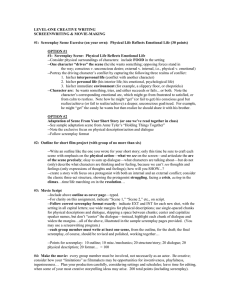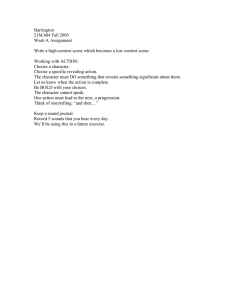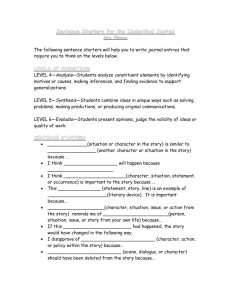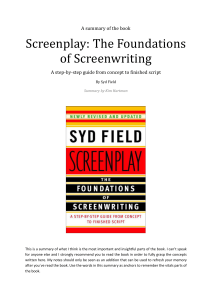SCREENWRITING #1: Screenplay Scene: Physical Life Reflects Emotional Life FOOD
advertisement
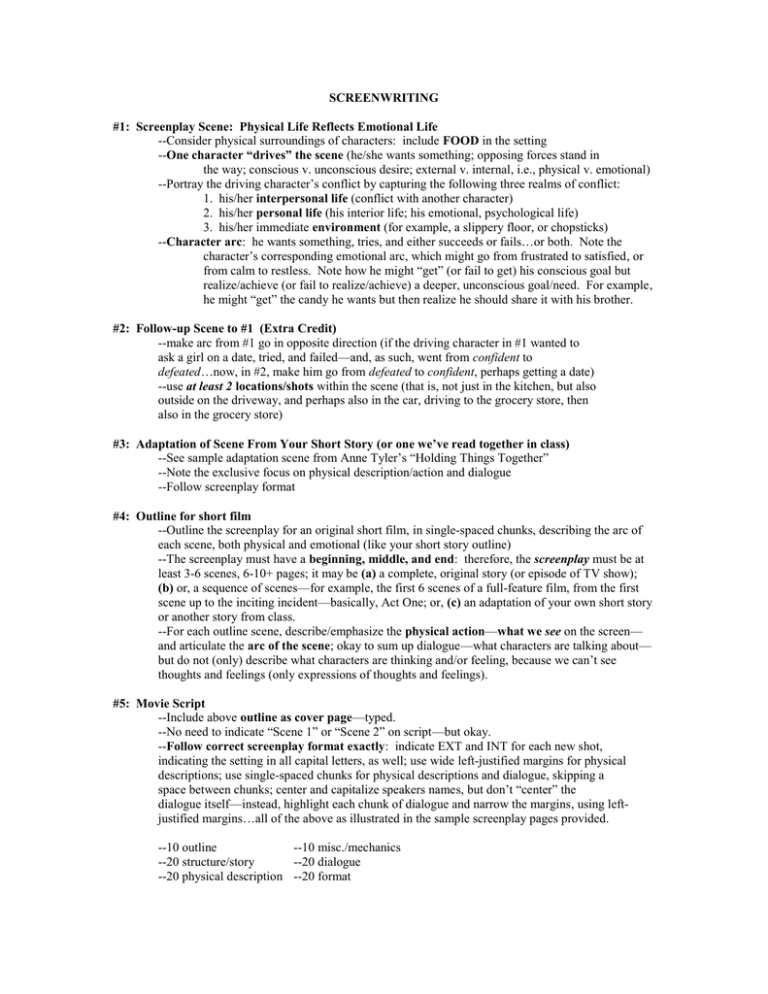
SCREENWRITING #1: Screenplay Scene: Physical Life Reflects Emotional Life --Consider physical surroundings of characters: include FOOD in the setting --One character “drives” the scene (he/she wants something; opposing forces stand in the way; conscious v. unconscious desire; external v. internal, i.e., physical v. emotional) --Portray the driving character’s conflict by capturing the following three realms of conflict: 1. his/her interpersonal life (conflict with another character) 2. his/her personal life (his interior life; his emotional, psychological life) 3. his/her immediate environment (for example, a slippery floor, or chopsticks) --Character arc: he wants something, tries, and either succeeds or fails…or both. Note the character’s corresponding emotional arc, which might go from frustrated to satisfied, or from calm to restless. Note how he might “get” (or fail to get) his conscious goal but realize/achieve (or fail to realize/achieve) a deeper, unconscious goal/need. For example, he might “get” the candy he wants but then realize he should share it with his brother. #2: Follow-up Scene to #1 (Extra Credit) --make arc from #1 go in opposite direction (if the driving character in #1 wanted to ask a girl on a date, tried, and failed—and, as such, went from confident to defeated…now, in #2, make him go from defeated to confident, perhaps getting a date) --use at least 2 locations/shots within the scene (that is, not just in the kitchen, but also outside on the driveway, and perhaps also in the car, driving to the grocery store, then also in the grocery store) #3: Adaptation of Scene From Your Short Story (or one we’ve read together in class) --See sample adaptation scene from Anne Tyler’s “Holding Things Together” --Note the exclusive focus on physical description/action and dialogue --Follow screenplay format #4: Outline for short film --Outline the screenplay for an original short film, in single-spaced chunks, describing the arc of each scene, both physical and emotional (like your short story outline) --The screenplay must have a beginning, middle, and end: therefore, the screenplay must be at least 3-6 scenes, 6-10+ pages; it may be (a) a complete, original story (or episode of TV show); (b) or, a sequence of scenes—for example, the first 6 scenes of a full-feature film, from the first scene up to the inciting incident—basically, Act One; or, (c) an adaptation of your own short story or another story from class. --For each outline scene, describe/emphasize the physical action—what we see on the screen— and articulate the arc of the scene; okay to sum up dialogue—what characters are talking about— but do not (only) describe what characters are thinking and/or feeling, because we can’t see thoughts and feelings (only expressions of thoughts and feelings). #5: Movie Script --Include above outline as cover page—typed. --No need to indicate “Scene 1” or “Scene 2” on script—but okay. --Follow correct screenplay format exactly: indicate EXT and INT for each new shot, indicating the setting in all capital letters, as well; use wide left-justified margins for physical descriptions; use single-spaced chunks for physical descriptions and dialogue, skipping a space between chunks; center and capitalize speakers names, but don’t “center” the dialogue itself—instead, highlight each chunk of dialogue and narrow the margins, using leftjustified margins…all of the above as illustrated in the sample screenplay pages provided. --10 outline --10 misc./mechanics --20 structure/story --20 dialogue --20 physical description --20 format
